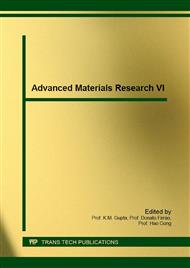[1]
A. J. S. Pippard and L. Chitty, The Civil Engineer in War, (London: Inst. Civ. Eng. ), Vol. 3(1948), p. (1948).
Google Scholar
[2]
J. F. Baker, The civil engineer in war, (London: Inst. Civ. Engrs. ), Vol. 3(1948), p.30.
Google Scholar
[3]
J. F. Baker, E. L Williams and D Lax, The Civil Enginer in War, (London: Inst. Civil. Engineers), Vol. 3(1948).
Google Scholar
[4]
G. L. Rogers, Introduction to the Dynamics of Framed Structures, (New York: Dover), (1959).
Google Scholar
[5]
G. Goldsmith, Impact: The Theory and Physical Behavior of Colliding Solids, (London Arnolds), (1960).
Google Scholar
[6]
B. Rawlings, Response of structure to dynamic loads, Institute of Physics conf. Ser., 21, 279, (1974).
Google Scholar
[7]
J. Harding, Mechanical Properties at High Rates of Strain, Institute of Physics Conference Series, No. 70, (1984).
Google Scholar
[8]
R. Kinslow, Stress waves in Composite Laminates, AEDC-TR-65-69, 1, June (1965).
Google Scholar
[9]
R. NADER, Unsafe at any speed, Second edition, Bantam Books, London, U.K., (1973).
Google Scholar
[10]
Volvo Car Corporation: Safety Down in the Smallest Detail, USA, (1962).
Google Scholar
[11]
A. I. O. Zaid and F. W. Travis, A Comparison of Single and Multi-Plate ShieldsSubjected to Impact by a High Speed Projectile. Institute of Physics Conf. Series No. 21, P. 417, (1974).
Google Scholar
[12]
U. N. Gandhiand J. Hu: Data Based Models for Automobile Side Impact Analysis and Design Evaluation, Int. J. Impact. Eng., Vol. 18, (1996), pp.517-537.
DOI: 10.1016/0734-743x(96)00043-7
Google Scholar
[13]
L. Wu, and J. F. Carney: Experimental Analysis of Collapse Behavior of Braced Elliptical Tubes Under Lateral Compression, Int. J. Mech. Sci., Vol. 40, (1998), pp.761-777.
DOI: 10.1016/s0020-7403(97)00121-5
Google Scholar
[14]
R. M. Abu-Malloh: Performance of Superplastic Tin-Lead Material as Energy Absorbing System, Ph. D Thesis, Jan. 2003, University of Jordan, Amman, Jordan.
Google Scholar
[15]
T. Y. M Al-Naib and J. L. Duncan: Superplastic Metal Forming, Int.J. Mech. Sci., Vo1. 2, (1970), p.463.
Google Scholar


